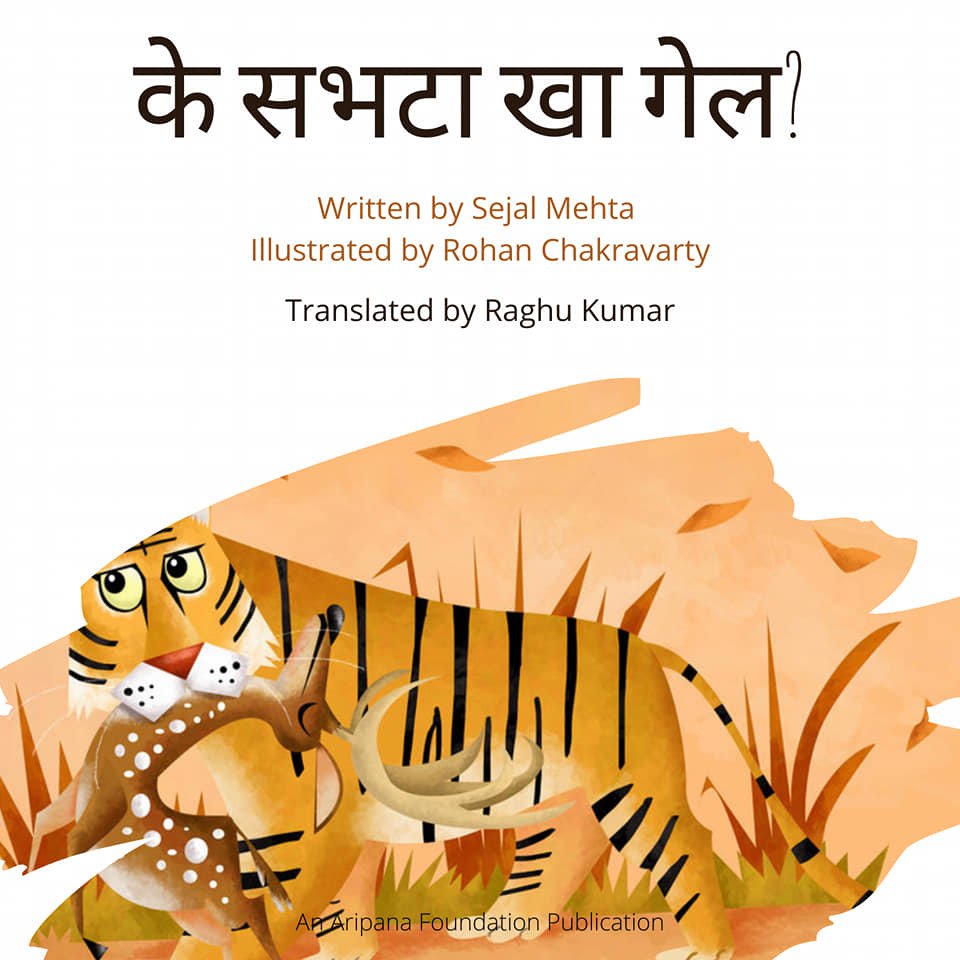It is a month since we started supporting the teachers of Bansidas Kanya Madhya Vidyalay, a government school in Darbhanga, North Bihar to engage with students online. The Science classes, held every Tuesday and Friday for an hour, have achieved a rhythm and a happy place in the lives of those involved!
On Tuesday, 8th June, we thought of starting the chapter जन्तुओं में पोषण / Nutrition in Human, Animals and Amoeba, a chapter in the 7th std Science syllabus, with a reading of an adorable English-Hindi bilingual book, “Who Ate All that Up?” Written by Sejal Mehta and illustrated by Rohan Chakravarty (translated into Hindi by Purnesh Kumar Tripathi), it added just the right humor to the explanation of how nothing goes to waste in a jungle! Everything is eaten by something or someone. The book was used to kickstart the sub topic of what animals eat for nourishment and later, discuss the concept of a food web!
We have learnt and we believe it is a good practice to read aloud the title of the book along with the name of the author and the illustrator! It brings the creators into focus and in some cases may forge deeper connections of the audience with the book. In this case, as the title was both, in Hindi and English, the facilitator read the Hindi title aloud and asked the students to read the English title. The children promptly volunteered to do so and in a similar manner, the rest of the session too focused on getting students to participate.
This book, meant for children aged 3-6, might prove to be a great read for children who find English particularly challenging and need practice with a short and fun book! The English sentences in this book are short, concise, simple, repetitive and supported with their Hindi counterpart! Bilingual books, where one of the languages is of comfort for children (in this case, Hindi) are advantageous to use inside classrooms to introduce children to another language they are learning / are not very comfortable with – in this case, English. Children could read the Hindi sentence first, which might help them in guessing what the English sentence is trying to say, thus, being one of the ways that help them to read it better! Through this book, children were introduced to new vocabulary in English like vultures, maggots, wild boar, fungi, hyena etc. while having the familiar Hindi words in front of them too!
What is even more amazing is the availability of “Who Ate all that up” in Maithili as के सभटा खा गेल? This book was translated into Maithili by Team Aripana, as part of a translation sprint undertaken with Pratham Books’ Storyweaver. Over 100 books for children aged 3 to 15 are now available in Maithili as a result of Aripana’s collaboration with Storyweaver. These books can be valuable resources inside classrooms in Mithila.
It was a rich experience for all involved, as an interdisciplinary approach was adopted where a science topic was approached through multiple languages that children are familiar with – their very own mother language Maithili, Hindi and English.
The session made use of the Read Aloud strategy as well as using attractive images and a video to better explain concepts in the lesson.
Throughout the session the children were encouraged to participate with the use of open-ended questions. Another way in which the facilitator ensured children speak was to suggest they repeat certain new words after her. Example: Maggots, hyena, wild boar, badger, coyote etc.
An effort was made to contextualize the lesson to enhance its relevance for children. While on the topic of human nourishment and important micro and macro nutrients that human body needs, Calcium was one of the minerals discussed. The facilitator gave clues to students in order to guess a calcium rich food, grown in ponds, specific to Mithila and an inseparable part of its culture! The children all answered in a loud chorus – Makhana or Fox nut indeed!
Similarly, while on the topic of Vitamin C, the facilitator asked students to remember what medical professionals are advising people to do during the pandemic, apart from maintaining social distancing, wearing masks, using sanitizers and washing hands! It was, boosting one’s immunity through the consumption of a balanced diet rich in Vitamin C! It was thus conveyed how important Vitamin C is in order to build immunity.
This and similar other ways were employed to make the class engaging, relevant and enjoyable to children.
It seemed that children had learnt the ropes of muting, un muting themselves after a month’s class! The session was less cacophonous and more decorum could be observed. A welcome development indeed.
We look forward to many more!



